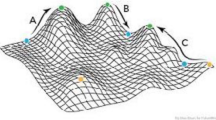Abstract
We consider, from a physical perspective, the case where the interface between an organism and its environment becomes large enough that it acts as a buffer regulating their matter and energy exchanges. We illustrate the physiological and evolutionary role of buffers through the example of lungfish estivation. Then we ponder the relevance of buffers of this kind to the quest for a general definition of concepts like niche construction, the extended phenotype, and related ones, whose meaning is conveyed at present mostly through particular examples. Finally, we comment on the potential significance of buffers to organism—environment codetermination in the sense originally suggested by Lewontin.

Similar content being viewed by others
References
Brillouin L (2004) Science and information theory, 2nd edn. Dover Phoenix Editions, New York
Chase JM, Leibold M (2003) Ecological niches. University of Chicago Press, Chicago, Chap. 2, 3
Dawkins R (1982) The extended phenotype. Oxford University Press, Oxford
De Groot SR, Mazur P (1962) Non-equilibrium thermodynamics. North Holland Publishing Company, Amsterdam
Elton E (1927) Animal ecology. Sidgwick and Jackson, London
Frisch U (1996) Turbulence. Cambridge University Press, Cambridge
Grinnell J (1917) The niche-relationships of the California thrasher. Auk 34:427–433
Hutchinson GE (1957) Concluding remarks. Cold Spring Harb Symp Quant Biol 22:415–427
Jablonka E, Lamb MJ (2006) Evolution in four dimensions. The MIT Press, Cambridge, Massachusetts
Jones CG, Lawton J et al (1994) Organisms as ecosystem engineers. Oikos 69:373–386
Jones C, Lawton J et al (1997) Positive and negative effects of organisms as physical ecosystems engineers. Ecology 78:1946–1957
Laland KN, Odling-Smee FJ, Feldman MW (1999) Evolutionary consequences of niche construction and their implications for ecology. Proc Natl Acad Sci USA 96:10242–10247
Landau LD, Lifshitz EM (1970) Statistical physics. Addison-Wesley Publishing Company, London, Sect. 20, pp 57–60
Lenton TM (1998) Gaia and natural selection. Nature 394:439–447
Lewontin RC (1983) The organism as the subject and object of evolution. Scientia 118:65–82
Odling-Smee FJ, Laland KN, Feldman MW (2003) Niche construction: the neglected process in evolution. Princeton University Press, Princeton
Pippard AB (1974) The elements of classical thermodynamics. Cambridge University Press, London, Chap. 7
Salamon P, Hoffmann KH et al (2001) What conditions make minimum entropy production equivalent to maximum power production? J Non Equilib Thermodyn 26:73–83
Schrodinger E (1967) What is life? Cambridge University Press, New York
Smith HW (1931) Observations on the African lung-fish, Protopterus Aethiopicus, and on evolution from water to land environments. Ecology 12(1):164–181
Stauffer PH (1979) A fossilized honeybee comb from late Cenozoic cave deposits at Batu Caves, Malay Peninsula. J Paleontol 53(6):1416–1421
Sugimoto T (2002) Darwinian evolution does not rule out the Gaia Hypothesis. J Theor Biol 218:447–455
Tolman RC, Fine PC (1948) On the irreversible production of entropy. Rev Mod Phys 20(1):51–77
Torres J-L (1991) Natural selection and thermodynamic optimality. Nuovo Cimento D13:177–185
Varricchio DJ, Martin AJ, Katsura Y (2007) First trace and body fossil evidence of a burrowing, denning dinosaur. Proc R Soc B 274:1361–1368
Author information
Authors and Affiliations
Corresponding author
Appendix
Appendix
Here we outline the thermodynamic analysis of matter and energy fluxes among the three nested objects in Fig. 1b.
First, we assume an interface that allows such exchanges at the organism–buffer boundary, plus a rigid, impermeable interface that isolates the buffer from the environment. Under such conditions we effectively have a two-body situation like that described by Eq. 1 above, thus obtaining for the work performed during this process,
where the subscript b denotes the buffer, and the superscript (ob) indicates that the corresponding exchanges occurred at the organism–buffer interface; \( \Updelta S^{{({\text{ob}})}}_{{{\text{total}}}} = \Updelta S^{{({\text{ob}})}}_{{\text{o}}} + \Updelta S^{{({\text{ob}})}}_{{\text{b}}}, \) where the superscript indicates that entropy was generated both at the organism and at the buffer when energy and matter transfers occurred at the organism–buffer interface.
Second, we now interchange the interfaces used in the first step, thus obtaining for the amount of work extracted from the ensuing buffer–environment exchange,
where \( \Updelta S^{{({\text{be}})}}_{{{\text{total}}}} = \Updelta S^{{({\text{be}})}}_{{\text{b}}} + \Updelta S^{{({\text{be}})}}_{{\text{e}}}; \) the (be) superscript indicates that all transfers now occur at the buffer–environment interface.
The total entropy produced in the whole process, involving simultaneous matter and energy transfers at both interfaces, is given by, \( \Updelta S^{{}}_{{{\text{total}}}} = \Updelta S^{{({\text{ob}})}}_{{{\text{total}}}} + \Updelta S^{{({\text{be}})}}_{{{\text{total}}}}. \) The total entropy generated within the buffer is thus, \( \Updelta S_{{{\text{b,total}}}} = \Updelta S^{{({\text{ob}})}}_{{\text{b}}} + \Updelta S^{{({\text{be}})}}_{{\text{b}}} , \) and the net amount of heat that flows through it during the whole exchange of matter and energy in the object–buffer–environment system is, \( \Updelta Q^{{}}_{{{\text{b,total}}}} = \Updelta Q^{{({\text{ob}})}}_{{\text{b}}} + \Updelta Q^{{({\text{be}})}}_{{\text{b}}}, \) where \( \Updelta Q^{{({\text{ob}})}}_{{\text{b}}} = T_{{\text{b}}} \Updelta S^{{({\text{ob}})}}_{{\text{b}}} \) flows at the object–buffer interface, and \( \Updelta Q^{{({\text{be}})}}_{{\text{b}}} = T_{{\text{b}}} \Updelta S^{{({\text{be}})}}_{{\text{b}}} \) flows at the buffer–environment one.
Similarly, from Eqs. A-1 and A-2 the total mechanical work performed by the buffer is, \( \Updelta W_{{{\text{total}}}} = (P_{{\text{b}}} - P_{{\text{o}}} )\Updelta V_{{\text{b}}} ^{{({\text{ob}})}} + (P_{{\text{b}}} - P_{{\text{e}}} )\Updelta V_{{\text{b}}} ^{{({\text{be}})}}, \) and the net change in buffer volume is given by, \( \Updelta V_{{\text{b}}} = \Updelta V_{{\text{b}}} ^{{({\text{ob}})}} + \Updelta V_{{\text{b}}} ^{{({\text{be}})}}. \)
Rights and permissions
About this article
Cite this article
Torres, JL., Trainor, L. On organism: environment buffers and their ecological significance. Biol Philos 23, 403–416 (2008). https://doi.org/10.1007/s10539-007-9107-5
Received:
Accepted:
Published:
Issue Date:
DOI: https://doi.org/10.1007/s10539-007-9107-5




